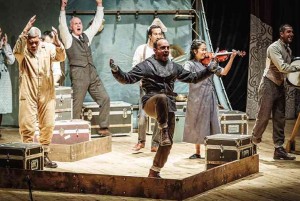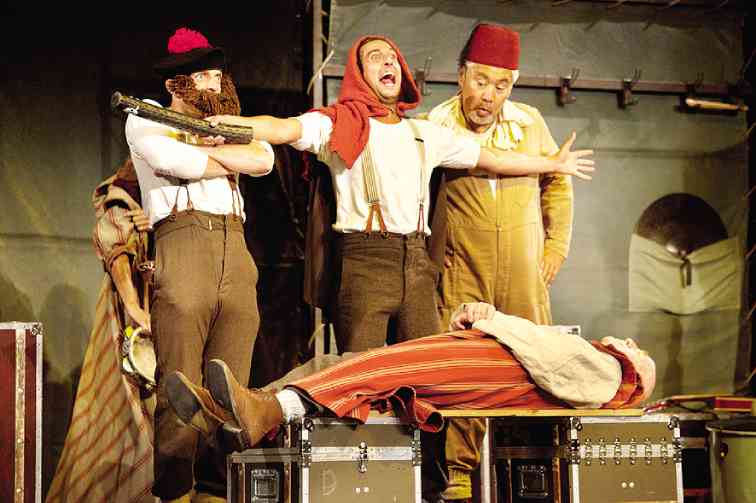
Seeing “Hamlet Globe to Globe” in Singapore a day after the Sept. 11 parliamentary elections that had been portrayed a make-or-break for the ruling People’s Action Party (PAP) seems anticlimactic for lovers of Shakespeare who would like to make metaphysical connections between his tragedies and real life.
Even Prime Minister Lee Hsien Loong had expected a close battle with the Workers Party and other opposition groups that in 2011 made a strong showing and so disgraced the PAP that Singapore founder Lee Kuan Yew resigned his largely ceremonial though still substantial position as “Elder Minister,” and George Yeo, a familiar Singapore face to the Philippine media since he was at one time information and later deputy minister, ringed the curtain down on his political career and went back to the private sector.
But the election results turned out to be anything but close. Singapore’s 9/11 was hardly catastrophic. The Workers Party barely held on to the seats they had won in 2011, and the PAP went on to win more than two-thirds of parliament.
If Lee Kuan Yew, who died last March, could be likened to the ghost of Hamlet’s father, he was a smiling phantasm on election day, grinning from ear to ear.
Before Singapore, “Hamlet,” a global touring production from Shakespeare’s Globe Theatre of London (hence, “Globe to Globe”), had performed in Manila.
Whose ghost roamed the Little Theater of the Cultural Center of the Philippines where it was mounted?

Ninoy and Cory whose son is now president? Fernando Poe Jr. whose daughter Grace landed first in the Senate election of 2013 based on the strong public sentiment over his earlier death hastened perhaps by his heartbreaking defeat through alleged cheating by Gloria Arroyo in 2004? (Grace Poe herself has now officially declared she’s running for president.)
Or Ferdinand Marcos whose son is likewise contemplating a presidential run most probably to vindicate his father’s corrupt dictatorship?
Fratricide
None of these ghosts, save for Ninoy’s, suffered the “primal eldest curse” of fratricide or homicide, none of them was killed; but in the context of the Philippines and its history of perceived slights and deadly grudges, everything is about politics and settling scores: It’s always the killing season, an obdurate landscape of vendetta and more vendetta.
So in contrast, Singapore’s was hardly a bloody affair. Although the setting was the refurbished Capitol Theatre, an “ancient” heritage structure by Singapore standards, there was none of the brooding primal or totem feeling of ancient curses and primitive wrongs.
On Capitol’s vast stage and amid its vast ceiling, the Globe put up a makeshift theater complete with curtain and trunks for costumes and props, in order to evoke the feel of a touring production, the dwarfish setting hardly the proper atmosphere for an atmospheric drama of ghosts and vendettas.
Fortunately for the Globe production, it was also the weekend of Singapore’s perennial curse—the Indonesian haze. It somehow conjured the uncanny terror of the Danish bog. But so thick and pervasive was the haze from the accidental fires of Indonesian forests that it seemed what would emerge from the vaporous mist wasn’t just vengeful spirits, but Grendel and his mother.

The touring production is a return to the roots of English theater since, before the rise of the original Globe and other theaters across Blackfriars Bridge during the Anglo Renaissance, theater was largely a nomadic affair. Theater companies trucked up to towns and performed in guildhalls, churches and inn yards.
Touring English actors might have in fact performed in the 1580s in Elsinore in Denmark, where “Hamlet,” first staged around 1601 with Richard Burbage playing the Danish prince of dilemmas, is set.
Shortest text
Of the three texts published during Shakespeare’s life, “Hamlet Globe to Globe” uses principally the Folio, the latest text to be published, thus, most probably the Bard’s final edited version. But where abridgment is necessary, director Dominic Drumgoole says the production draws from the First Quarto, the first version and “the most impure,” not only because “brevity is the soul of wit,” but, as the director points out, because it “has a robust energy and a winning ability to get on with it.”
The result is a story that propels itself toward the sheer inexorability of tragedy after tragedy, of “getting on with it.”
Drumgoole appears to have further truncated the production by letting the famous play-within-a-play be staged wordlessly through pantomime. But this may have lessened the tragic effect as the comic element tends to brighten up the mood.
Still, lessening the play’s import and portent may have been really his intention. This may be gleaned from the play’s closing when the dead Hamlet reunites with the soul of the suicide Ophelia and with the other ghosts, dance not a macabre, but a merry ball of sheer lightfooted- and -heartedness.
One can surmise the reasons the drama ends in hardly the usual Hamletesque fashion. It could be because the production —since opening in 2014—hopes to tour all of the world’s 205 countries, and seeking to provide a positive image for Great Britain, may not be wont to serve the usual dish of bloodshed and sensational gore from Shakespeare and Elizabethan drama.
Most probably, too, considering the Syrian refugee crisis, the carnage of Isis, the tit-for-tat in Israel, the Chilean earthquake, the Chinese clampdown on dissidence and the outbreaks in Africa, violence is ubiquitous, it breaks out “Globe to Globe,” and nothing is really shocking anymore.
This may be the old “unknowing world” to which the wizened Horatio has expressed his wish of giving his blood-spattered account: ”… so shall you hear of carnal, bloody and unnatural acts, of accidental judgements, casual slaughters, of deaths put up by cunning and forced cause … all this can I truly deliver.”













































